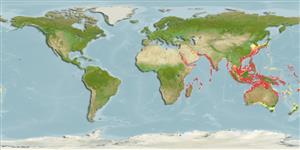Environment: milieu / climate zone / Tiefenbereich / distribution range
Ökologie
seewasser riff-verbunden; tiefenbereich 37 - 110 m (Ref. 11441). Tropical
Indo-West Pacific: Red Sea (Ref. 3141) and East Africa to Indonesia, north to southern Japan, south to northern Australia. Immigrated into the southeastern Mediterranean through the Suez Canal.
Size / Gewicht / Alter
Geschlechtsreife: Lm ? range ? - ? cm
Max length : 30.0 cm TL Männchen/unbestimmt; (Ref. 9806); common length : 20.0 cm TL Männchen/unbestimmt; (Ref. 9661)
Rückenflossenstacheln (insgesamt) : 0; Rückenflossenweichstrahlen (insgesamt) : 9; Afterflossenstacheln: 0; Afterflossenweichstrahlen: 9 - 10.
Body shape (shape guide): short and / or deep.
Inhabits deep coastal slopes and sheltered muddy substrates, usually in deep water offshore, but occasionally shallow near seagrass beds with silty rubble substrates (Ref. 48637). Usually occurs in sandy bottoms in coastal waters. Solitary (Ref. 90102). Feeds on benthic invertebrates. Generally considered as trash fish; not consumed. Its flesh and organs are poisonous (IUCN, http://www.iucnredlist.org/details/154933/0) however,
Life cycle and mating behavior
Geschlechtsreife | Fortpflanzung | Ablaichen | Eier | Fecundity | Larven
Matsuura, K., 2001. Ostraciidae. Boxfishes. p. 3948-3951. In K.E. Carpenter and V. Niem (eds.) FAO species identification guide for fishery purposes. The living marine resources of the Western Central Pacific. Vol. 6. Bony fishes part 4 (Labridae to Latimeriidae), estuarine crocodiles. FAO, Rome. (Ref. 9806)
IUCN Rote Liste Status (Ref. 130435: Version 2025-1)
Bedrohung für Menschen
Venomous
Nutzung durch Menschen
Fischereien: weniger kommerziell; Aquarium: Potenzial
Tools
Zusatzinformationen
Download XML
Internet Quellen
Estimates based on models
Preferred temperature (Ref.
123201): 22.2 - 28.2, mean 26.9 °C (based on 480 cells).
Phylogenetic diversity index (Ref.
82804): PD
50 = 0.5625 [Uniqueness, from 0.5 = low to 2.0 = high].
Bayesian length-weight: a=0.04898 (0.02799 - 0.08571), b=2.74 (2.58 - 2.90), in cm total length, based on LWR estimates for this species & (Sub)family-body (Ref.
93245).
Trophic level (Ref.
69278): 3.1 ±0.23 se; based on food items.
Widerstandsfähigkeit (Ref.
120179): hoch, Verdopplung der Population dauert weniger als 15 Monate. (Fec assumed to be > 10,000).
Fishing Vulnerability (Ref.
59153): Low vulnerability (20 of 100).
🛈
Nutrients (Ref.
124155): Calcium = 44.1 [18.9, 108.3] mg/100g; Iron = 0.624 [0.321, 1.403] mg/100g; Protein = 18.3 [16.1, 20.4] %; Omega3 = 0.124 [0.064, 0.235] g/100g; Selenium = 42.6 [21.8, 87.9] μg/100g; VitaminA = 52.4 [15.2, 188.7] μg/100g; Zinc = 1.09 [0.74, 1.61] mg/100g (wet weight);
